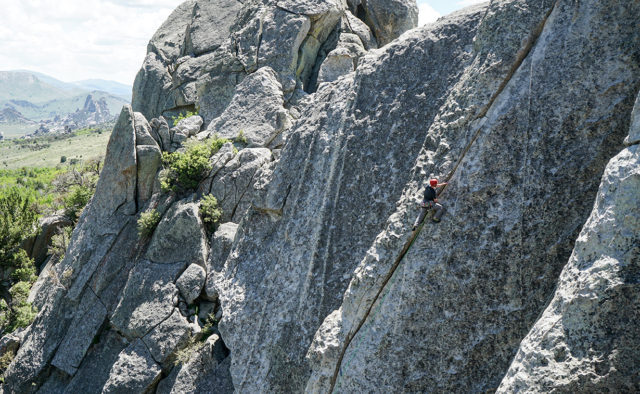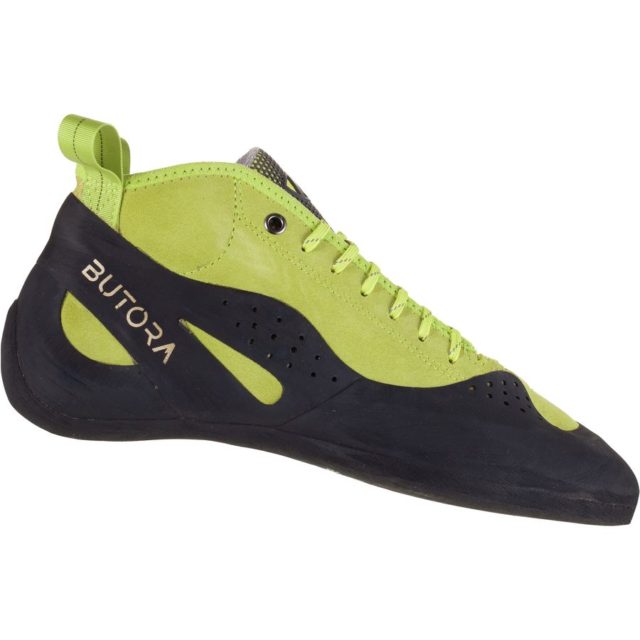Available Sizes: US Men’s 4-14 (including half sizes)
Reviewer’s Street Shoe Size: 13
Size Tested: 13.5
Stated Features:
- Butora’s own NEO Fuse sticky rubber
- 100% Organic Hemp lining to control stretch and odor
- German leather upper, the best leather we can find
- Open cell Poron foam tongue for all day jamming comfort
- Closed cell foam padded ankle protection
- Ample rubber for protection and grip
- Moisture-wicking split leather footbed
MSRP: $155
Test Locations: Squamish, BC; Yosemite National Park, CA; Indian Creek, UT; City of Rocks, ID; Rocky Mountain National Park, Clear Creek Canyon, Boulder Canyon, & South Platte, CO
Days Tested: ~35
Intro
Founded in South Korea in 2014, Butora is relatively new to the climbing shoe world. The brand’s lead designer is Nam Hee Do, who worked for years at Five Ten and Evolv, and was the man behind the Evolv Shaman.
Butora now has a wide range of shoe options, from aggressive bouldering models to comfy trad shoes. They’re also one of a handful of brands that has come out with a high-top trad shoe since the runaway success of the La Sportiva TC Pro. Shoes in this category are meant to excel in cracks, on slabs, and offer enough comfort for long days on the wall.
While the TC Pro continues to dominate this category, Butora’s offering, called the Altura, is the first shoe I’ve tried that offers a compelling alternative to the TC Pro, particularly if you’ve got larger or higher-volume feet.
Fit
Butora offers the Altura in both wide (green) and regular (red) versions. For the Altura, Butora actually recommends that climbers size up 1 full size from their street shoe size for a comfort-oriented fit, and size up a half-size for a more aggressive fit. I ended up choosing the size 13.5 wide (green) Altura, which is a half-size up from my street shoe size (13). While I’m not used to sizing up in my climbing shoes, the Altura fits me perfectly. I don’t have much dead space and I can wear it comfortably all day.
Beyond granite and sandstone cragging around Colorado and Utah, I also brought the Altura to Squamish and Yosemite for long, single-day free routes as well as a trip up El Cap via Lurking Fear. In all these climbing settings, the Altura provided a great combination of a snug fit while remaining comfortable for long days on the wall.
Anatomy and Performance
The Altura has a leather upper, a sole that’s stiff from the midfoot all the way through the toe box, and a heavily padded tongue. Overall, this shoe is very comfortable.
The contours of the Altura’s toe box have sharper corners than some other non-aggressive shoes like the Evolv General and Astroman. The Altura resembles the TC Pro in this way, and this sharper toe box allows for the same precision that climbers have come to expect from the TC Pro.
The Altura’s toe box is also relatively low profile which is great for when the crack narrows down from hands to off-fingers. This is another reason to really get your size and width preference dialed for the Altura — the better the fit through the front of the shoe, the more you’ll be able to take advantage of the lower-profile toe box.
Much like the TC Pro, the Altura has a flat, powerful inside edge that makes it easier and somewhat less tiring to walk up thin faces holds. Unsurprisingly, this stiffness comes at the cost of some sensitivity.
This is a fundamental tradeoff in nearly all climbing shoes. Softer shoes (e.g., Five Ten Moccasym, Sportiva Katana Velcro, or Tenaya Ra) provide greater sensitivity on the rock and more play when working rubber onto the edges of thin cracks. On the other hand, shoes with stiffer soles (e.g., TC Pro, Five Ten Anasazi Guide, etc.) are less prone to “rolling” off of holds, as well as less tiring to climb in over the course of a big day. This is a universal tradeoff, rather than something specific to the Altura.

The rubber on the Altura is Butora’s NEO Fuse compound, which is relatively soft (it’s softer than Vibram’s XS Grip2 rubber). I found the NEO Fuse rubber to work really well on slabs, but the combination of such a soft rubber and a pretty stiff shoe struck me as odd. Since the Altura is so insensitive, I feel that it loses some of the benefits of a softer rubber. Additionally, because it’s sometimes difficult to feel small holds with the Altura, the softer rubber occasionally feels like it’s rolling off crimps on vertical terrain. On the other hand, the softer rubber does make the shoe feel very secure when torquing the toe box or outside rand in a corner where friction is paramount.
Other Details / Features
Butora also did a great job of dialing in the details on the Altura. There’s extra padding behind the top eyelets to protect your ankle bone in wide cracks, doubling down on the high top idea. The outside edge of each toe box also has two loops of leather rather than normal eyelets (which are used on the rest of the shoe) so that the laces themselves are kept clear of cracks that will handily shred them if given the chance.
Altura vs TC Pro
Since the TC Pro is such an important reference point for any shoe of this type, it’s worth directly comparing these two shoes a bit more.
My central problem with the TC Pro is a subjective one: even the size 46 (the largest size La Sportiva makes in any of their shoes) is a little too snug for my foot. My toes end up a little too bent to be comfortable in thinner cracks, and this negates a lot of the performance generated by the TC Pro’s design. Now when I’m looking for something that’s a little on the snug side, I reach for my Katana’s instead — since that shoe is softer it conforms a bit more to my foot, which at least partially addresses the problem I have in the TC Pro.
By contrast, the Butora Altura is not only offered all the way up to a US Men’s size 14 (with half sizes all the way), but it also comes in regular and wide versions. It’s hard for me to overstate how much I welcome this sizing scheme. For all the fuss that is made every year about new climbing shoe tech, the reality is that fit is still one of, if not the most important factor when choosing shoes. Offering a greater range of options opens up the possibility of a better fit for a larger number of people.
My less-subjective gripe with the TC Pro is the well-known rand delamination issue on the outside of the shoe where the rand meets the leather upper near the pinkie toe. This doesn’t affect performance terribly, and many climbers I know who swear by the TC Pro have concocted all sorts of fixes and workarounds using seam sealer or other adhesives. However, I have yet to experience or hear about the same issue occurring on the Altura, and the Altura has held up remarkably well during my ~35 days in it.
In terms of performance, the main difference I found between the Altura and TC Pro is that the Altura has a slightly stiffer toe box, but is more pliable through the arch of the shoe. The Altura does lose some sensitivity due to its stiffer toe area, but the TC Pro also isn’t the most sensitive shoe to begin with.
The Altura’s softer mid-foot construction doesn’t really help with on-rock sensitivity, but the flexibility around the middle of the shoe does make it easier to torque the shoe when setting a jam. This more flexible midfoot area is also great for oozing onto slabs — it’s much easier to drop my heel with the extra give provided by the softer midsole. I came to really like the Altura’s combination of a stiffer toe box and softer midfoot, though it takes some getting used to whenever I break them out for the first time in a while because I’ve come to prefer more sensitive shoes when climbing on steeper terrain.
Bottom Line
The Butora Altura is an awesome shoe for cracks, slabs, and all-day climbing. It is thoughtfully designed and extremely well-constructed. Like most shoes in this class, the Altura is stiff and not very sensitive, which might be problematic for certain climbers. So if you’re looking for a softer shoe that still offers a high level of performance on granite, I strongly suggest checking out the Tenaya Ra or La Sportiva Katana Lace.
Otherwise, the Altura does everything the La Sportiva TC Pro does, but in a more customizable set of widths and sizes, and without the rand delamination issue that plagues the TC Pro. Both shoes work very well on granite, so it really just comes down to fit and preference in terms of stiffness (though they’re relatively close in this regard). Ultimately, if you’re looking for a shoe to help with long days of cracks and slabs, I think your best bet is to try on both the Altura and TC Pro, then go with whichever shoe fits you best.


Any plans to compare/review the new Scarpa Maestro (Mid)?
Indeed! None of the reviewers, myself included, had used the Maestro mid at the time of writing, so we didn’t include any comparative statements, but we’re planning on having a dedicated review out on the Maestro a bit later on in the season.
I bought a pair of Butora Mantras and they have broken in quite nicely. My street shoe size is 13 and I went with a size 14 in the Mantras. I then bought a pair of the Alturas in size 14. But the fit is just way too tight in the toe box. I believe this is due to the slight asymmetry in the Alturas. My toes curled against the front of the shoe a bit too much and they were cramped together too tightly across the width, especially compared to the Mantras. I could tell that they would not break in like the Mantras did so I just returned them. The lesson I learned (at least with Butora): the same size does not automatically guarantee the same fit across the range of models they offer. I think I will give the Scarpa Maestro Mids a try.